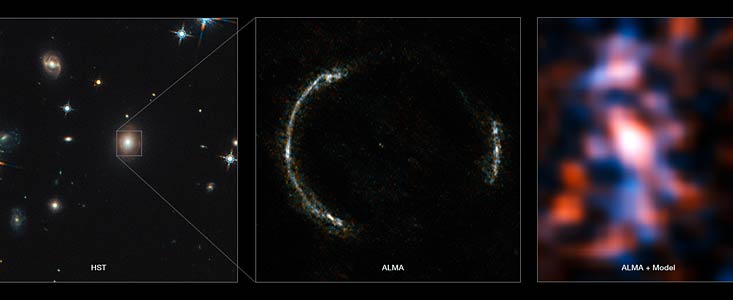

When Einstein first devised his theories of general and special relativity, they were accompanied by many predictions. One prediction was gravitational lensing. If you aren’t familiar with this phenomena, it essentially deals with gravity and the effect this force has on the fabric of spacetime and on light itself. When something of sufficient mass forms, like a supercluster, for instance, the fabric of space is warped so strongly that, when light passes through this region relative to Earth, objects in the background are magnified by several magnitudes—hence the ‘lensing’ part.
Over the years, this feature of relativity has been proven over and over again. Most recently, researchers with NASA used gravitational lensing to glimpse a distant supernova not once, but four different times. Now, astronomers from the European Southern Observatory (ESO) have done it once again—this time using ALMA’s Long Baseline Campaign.
The distant galaxy, called HATLAS J090311.6+003906 (otherwise known as SDP.81), is unlike anything we’ve ever found in terms of quality and detail (especially when distance is factored in). ALMA, which imaged the protoplanetary disk of a star just last year, has certainly outdone itself. It clearly resolves star forming clumps and HII regions—the ESO compares them to “giant versions of the Orion Nebula.”
Ultimately, the lensing effect seen with SDP .81 has created a bizarre circular-structure known as an Einstein Ring. The images alone have yielded quite a bit of information pertaining to the galaxy–including “structure, contents, motion, and other physical characteristics.”

As the ESO notes:
At least seven groups of scientists have independently analyzed the ALMA data on SDP.81. Their flurry of research papers has divulged unprecedented information about the galaxy, revealing details about its structure, contents, motion, and other physical characteristics.
ALMA acts as an interferometer. Simply speaking, the array’s multiple antennas work in perfect synchrony to collect light as an enormous virtual telescope. As a result, these new images of SDP.81 have a resolution up to 6 times higher than those taken in the infrared with the NASA/ESA Hubble Space Telescope.
The astronomers’ sophisticated models reveal fine, never-before-seen structure within SDP.81, in the form of dusty clouds thought to be giant repositories of cold molecular gas—the birthplaces of stars and planets. These models were able to correct for the distortion produced by the magnifying gravitational lens.
As a result, the ALMA observations are so sharp that researchers can see clumps of star formation in the galaxy down to a size of about 200 light-years, equivalent to observing giant versions of the Orion Nebula producing thousands of times more new stars at the far side of the universe. This is the first time this phenomenon has been seen at such an enormous distance.
“The reconstructed ALMA image of the galaxy is spectacular,” says Rob Ivison, co-author of two of the papers and ESO’s Director for Science. “ALMA’s huge collecting area, the large separation of its antennas, and the stable atmosphere above the Atacama Desert all lead to exquisite detail in both images and spectra. That means that we get very sensitive observations, as well as information about how the different parts of the galaxy are moving. We can study galaxies at the other end of the universe as they merge and create huge numbers of stars. This is the kind of stuff that gets me up in the morning!”
[Reference: European Southern Observatory]
The researcher also conducted a spectral analysis of SDP.81, which allowed them to infer its mass and rotation. This, in turn, helped them determine that the galaxy may soon experience a starburst period. Moreover, based on the inherent instability of the galaxy’s supply of gas, it would seem as if this new era of star formation will begin sooner rather than later.
Another fascinating, final bit of information, points to the existence of a supermassive black hole looming in the central nucleus of the foreground galaxy (the one providing the gravitational lense)—weighing between 200 and 300 million solar masses.
“The number of papers published using this single ALMA dataset demonstrates the excitement generated by the potential of the array’s high resolution and light-gathering power. It also shows how ALMA will enable astronomers to make more discoveries in the years to come, also uncovering yet more questions about the nature of distant galaxies,” they said.
From Quarks to Quasars is two people, Jaime and Jolene. We want to make the world a more sciencey place. We’re doing that, but with your help, we can do even more.
FQTQ takes a lot of time, money, and effort. Here, you can support us, get to know us, and access extra content: